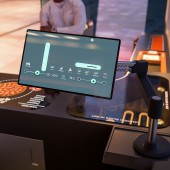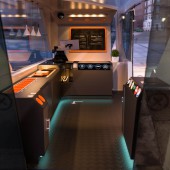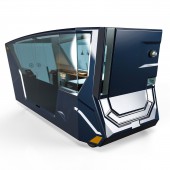Culinary Coach Autonomous Food Truck by Cody Moore |
Home > Winners > #57168 |
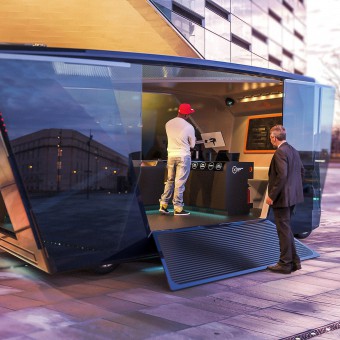 |
|
||||
| DESIGN DETAILS | |||||
| DESIGN NAME: Culinary Coach PRIMARY FUNCTION: Autonomous Food Truck INSPIRATION: Food trucks are aesthetically uninspiring, have offensive user experiences, and offer less than pleasing work environments. This design is a new solution, one that doesn't rely on repurposing existing vehicles as per current methods, and creates and entirely new experience for the new century. UNIQUE PROPERTIES / PROJECT DESCRIPTION: Culinary Coach is a concept for a food truck adapted to an autonomous world, and a day when large companies start encroaching on the mobile food market. The truck is fully autonomous in both driving and operation, and utilizes the newest technologies to expedite and improve the overall experience. The design and form focus on the customer experience, ease and effectiveness of sanitation, and a positive overall effect on the environment. OPERATION / FLOW / INTERACTION: The customer walks up to the vehicle and enters via the ramp into the vehicle. The large side windows allow them to see how full the vehicle is and gauge their approach appropriately. Sunlight is allowed to flow through the large overhead glass panels, charging the vehicle batteries and illuminating the interior. The customer approaches the ordering table and is greeted by the barista. They place the order and pay for their food using the touchscreen table. The table is based off of Pizza Huts conceptual UI, where they swipe ingredients right onto the pizza with gestures. Once the order is placed the table begins to cook the food, and the customer walks over to pour their drink from the drink machine. They place their cup inside and the machine fills it with the customers preferred drink, then raises it slowly from the center of the machine. This low center of gravity assists the vehicle during turns. Throughout this time the “barista” is assisting the user through their experience, as well as monitoring all aspects of the vehicle through the touch screen control panel in the cockpit. The food is prepared and comes out on the conveyor belt. The customer grabs the food and proceeds to the condiment station, where they are presented with an array of choices. For a trash can they are offered a standard receptacle or a recycling station bin. PROJECT DURATION AND LOCATION: The project was started in September of 2016 in Savannah, GA and finished in December of that same year. |
PRODUCTION / REALIZATION TECHNOLOGY: When the team approached the task of redefining the experience of mobile food, it was immediately realized that designing a food truck requires extensive knowledge of all aspects related to the industry and users. Laws and regulations regarding autonomous vehicles, mobile food, culinary standards, etc, were researched as well as ways that these laws might change in the conceptual timeline of the vehicle. Users of current food trucks were interviews, surveys were sent out, interviews with people in the field were researched, emerging technologies investigated, and the latest in the automotive world was carefully considered. This phase took 5 weeks to complete. During research the team came across two emerging technologies, that when combined, could create a unique and novel experience for the customer. There is a brand of vending machine in Italy and other countries that creates a whole fresh pizza from scratch. Seconds after placing your order, the machine mixes the dough, rolls out the pizza, spreads on the sauce, and cooks the entire meal in only 3 minutes. This technology, applied to a food truck and a limited menu, would be groundbreaking. This, combined with the emerging omnipresence of self-driving technology, could create a completely autonomous vehicle that serves a limited menu without the size of a conventional kitchen A fiberglass exterior was chosen to reduce weight and limit the tooling that the vehicle panels would need. In addition,many pre-manufactured parts such as the base chassis, engine, drivetrain, and wheels were incorporated. Strength and durability were also key in the material choice for the interior and exterior, as these vehicles would be designed to last for the entire lifetime of the business model that included them. To best design and customize the customer experience, no time was spared in creating a full scale cardboard mockup of the interior of the truck. The feedback was incredibly positive, as the majority of users appreciated the approach that we took towards the interior. The team incorporated some advice from user feedback, such as the addition of a “barista” and improvements to the overall design and heights of the tables. After considering human factors and finalizing the design and layout, the final design was revealed. The final versions were sketched, and the team conceived the entire vehicle in solidworks to finally realize the design. The entirety of the vehicle was designed in CAD including chassis, motor, drivetrain, and exterior paneling. The team completed the CAD design and 3d printed the entire model. SPECIFICATIONS / TECHNICAL PROPERTIES: The truck was conceived and delivered digitally, however a 1:15 scale model was 3D printed and delivered as an accurate representation of the vehicle. The digital model was highly detailed, and considered every detail of the vehicle. Electric motors, accurate scale batteries, electrical considerations, suspension, mountings, and other details were all included to create the most comprehensive vehicle design possible. TAGS: Food, Truck, Vehicle, Transportation, Culinary Coach, Automobile, Car, Mobile Food RESEARCH ABSTRACT: Initially, the research phase of the project revolved around existing food trucks, their operators, and the laws needed to keep them operating safely. The team delved deep into US road safety laws to determine what restrictions were placed on these vehicles, investigating aspects ranging from interior food friers to the air filtration systems. Also of great importance were existing brands and their systems of workflow; why were the popular brands successful, and what led to their success. When automation was added to the equation as a solution to the chosen problem, the scope of research broadened. This new branch included current technologies and their incorporation, users perceptions of self-operating technology, and the power systems needed to operate such devices. After these stages were complete, the UI and user experience were at the forefront. We looked into current solutions by major brands, and delved deep into peer-reviewed articles on how customers feel most comfortable interacting with new and complicated technologies. This also concerned the vehicle layout, for which we made full size mock-ups and had users rate the experience. CHALLENGE: The most difficult aspect of this vehicle design was abiding by the multitude of regulations regarding food distribution and cooking environments, road laws, and the regulations placed on mobile food stations. This was a difficult, but necessary part of our 5 week research effort. The six members of our team spent every available second making sure that our vehicle not only met these specifications, but adapted them to a world where autonomous vehicles are the standard and not the outlier. ADDED DATE: 2017-03-29 16:23:36 TEAM MEMBERS (6) : Cody Moore, Jordan Jones, Aditi Vyas, Yulin Liu, Tom Rouine and Fernando Zeledon IMAGE CREDITS: Cody Moore, 2017. |
||||
| Visit the following page to learn more: https://www.behance.net/gallery/46568471 |
|||||
| CLIENT/STUDIO/BRAND DETAILS | |
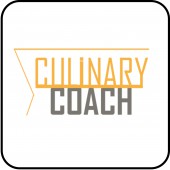 |
NAME: Culinary Coach PROFILE: This project is the result of a one time cooperation between talented graduates from the Savannah College of Art and Design. |
| AWARD DETAILS | |
 |
Culinary Coach Autonomous Food Truck by Cody Moore is Winner in Car and Land Based Motor Vehicles Design Category, 2017 - 2018.· Read the interview with designer Cody Moore for design Culinary Coach here.· Press Members: Login or Register to request an exclusive interview with Cody Moore. · Click here to register inorder to view the profile and other works by Cody Moore. |
| SOCIAL |
| + Add to Likes / Favorites | Send to My Email | Comment | Testimonials | View Press-Release | Press Kit |
Did you like Cody Moore's Car Design?
You will most likely enjoy other award winning car design as well.
Click here to view more Award Winning Car Design.



